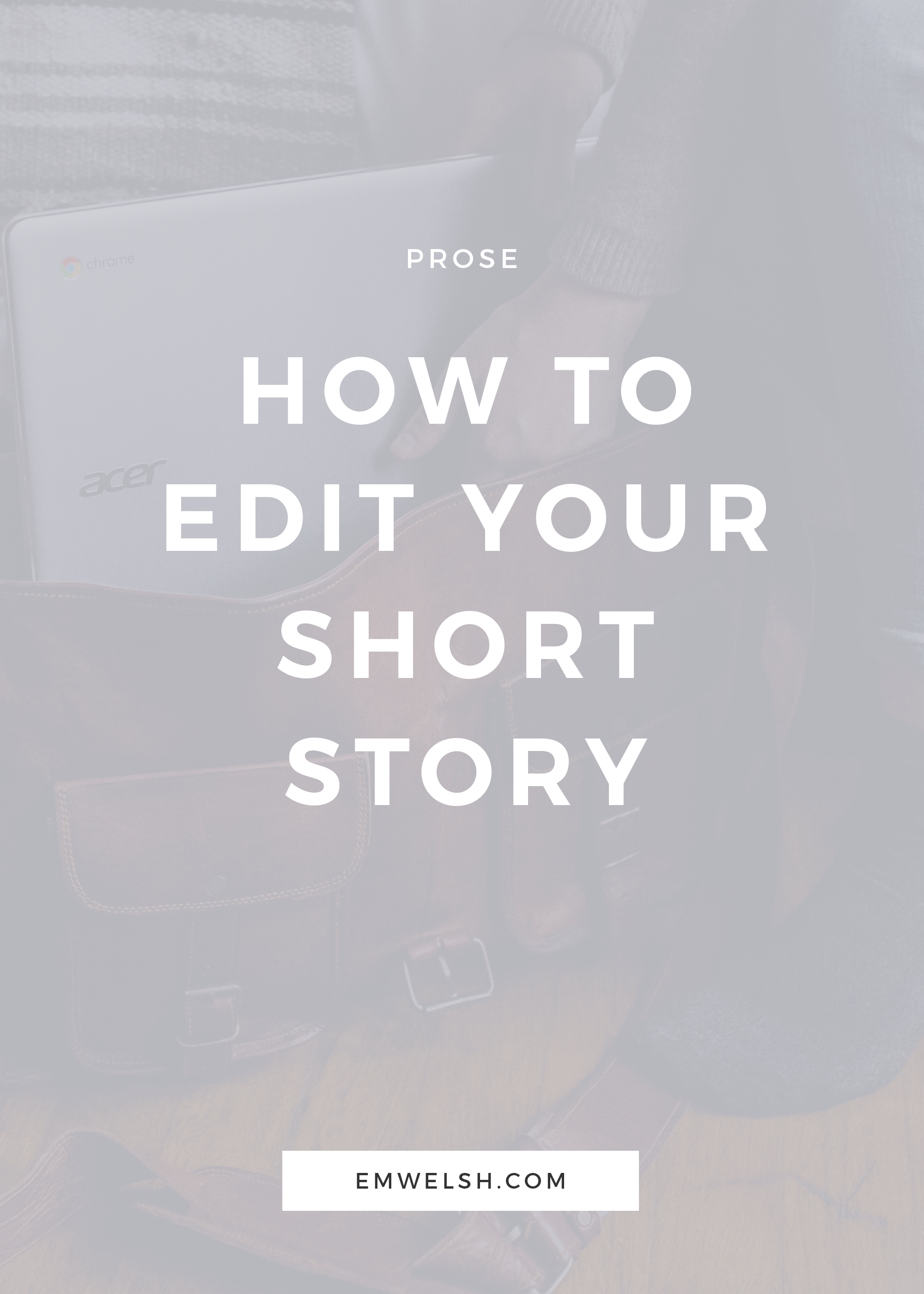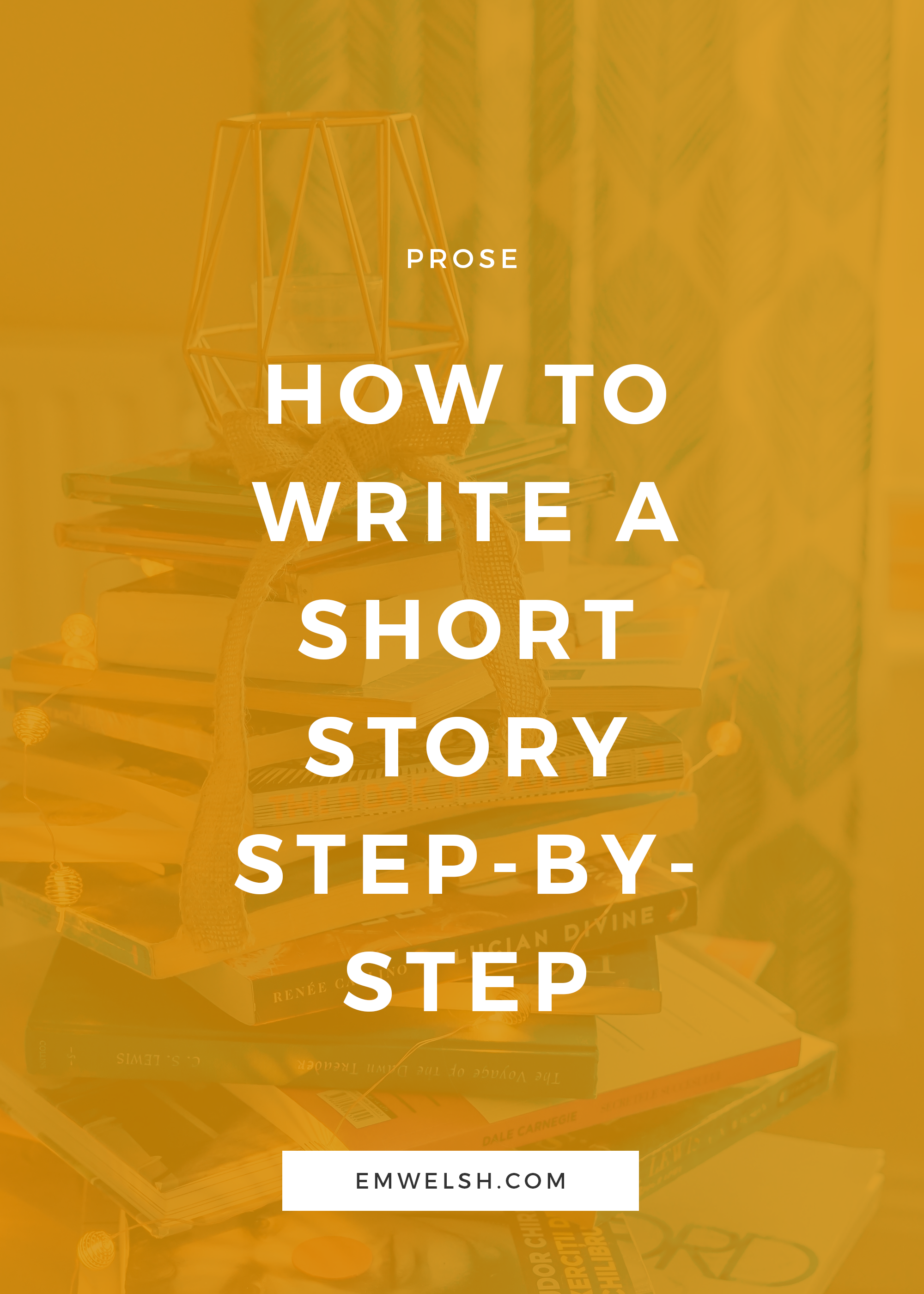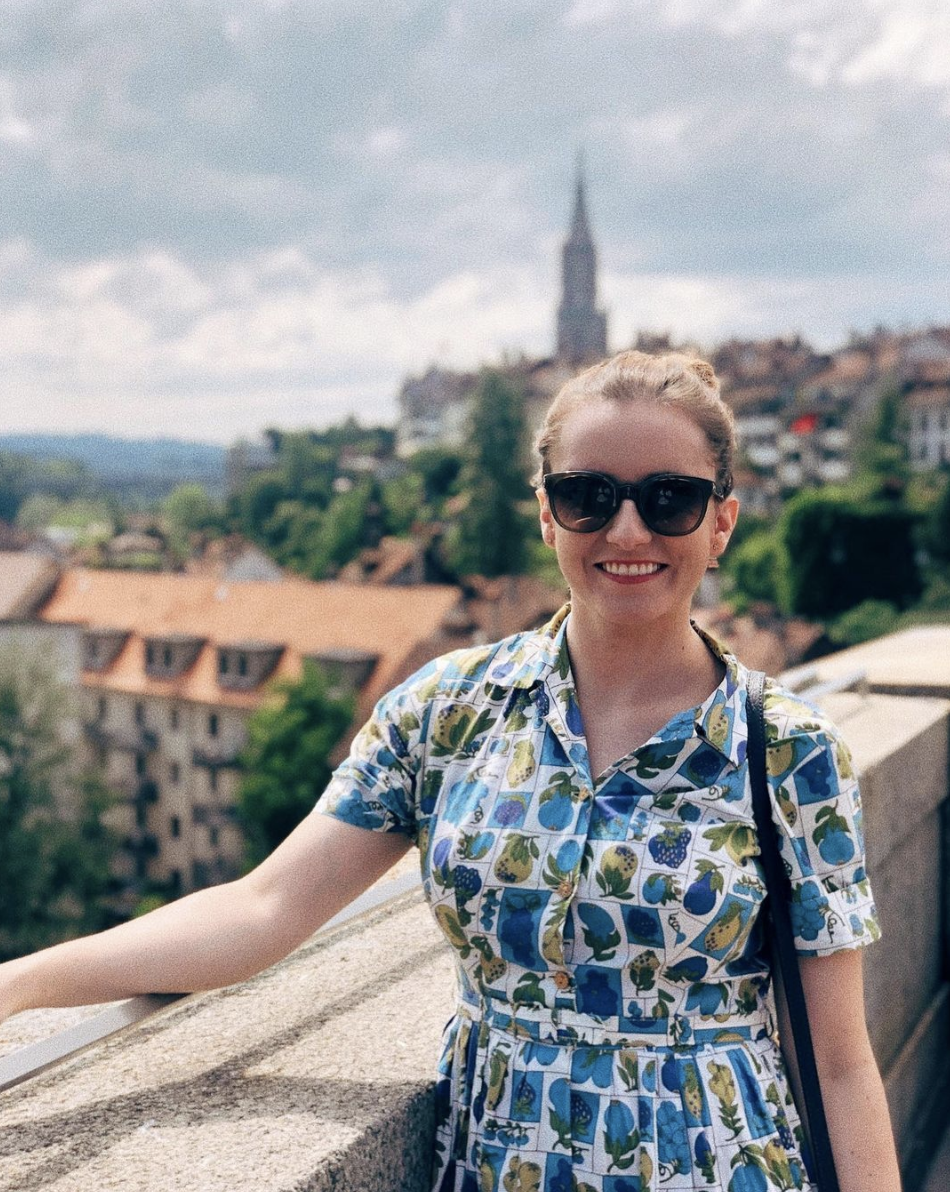How to Edit Your Short Story
/Finishing a short story is one of the most exciting things a storyteller can experience. Often this is achieved in a short time, so you still have the rush of excitement and enthusiasm for your work that writing a novel may not permit. For that reason, you may be eager to start editing your story as soon as possible, but not know where to begin.
There are many ways to edit a short story. Every person has their own unique approach. Below is a method that can help you start your editing process but by no means is the end-all-be-all approach to editing. If you need a starting point for your editing process, use the step-by-step guide below to learn how to edit your short story, be it the first draft or the last!
How to Edit Your Short Story
Before you begin to edit
Before you do anything with your short story, you'll want to make sure that you've given yourself enough time away from your story. This is important because if you look at your short story too soon, you won't have a fresh perspective and may miss certain areas you can improve upon. Or, alternatively, you may over-edit your piece because you're being too critical.
For that reason, give yourself no less than six weeks away from your short story before you begin editing it. This is six weeks away from the day you finished the story and last looked at it. This will ensure that you can approach editing with the appropriate editing perspective.
Step 1. Print out your story
Once you're ready to edit your short story, print it out, no matter the page count.
In printing out your story, you get the advantage of seeing your words on paper. You also omit the chance for distractions by being away from any electronics that could further distract you. If you plan to share this story with other people, you'll want to go ahead and print out several drafts.
Step 2. Read your story out loud
The first time you read your story after six weeks, sit down by yourself and read it out loud. Keep the pen away from you and read it like someone who is a fresh reader just along for the enjoyment of the story. Try your best not to take any mental notes.
Afterward, you can evaluate your feelings and reaction, but when you read this first draft do not make any notes on the paper about the actual story. You don't want to taint your editing process. Instead, you can write down your reaction after you've finished reading the story out loud.
Step 3. Read your story again, taking notes this time
Read your story out loud again, but this time break out the pen.
There is no hard or fast rule on what notes to take. Focus on your reactions to the story. If you love a section, mark it with a heart. If you hate a section, draw a line through it. If you're confused, write question marks by that sentence.
Use this time to scratch out sentences, jot down synonym ideas, question a line of dialogue. Mark all over the page if you feel you need to. Just listen to your gut and react to the words on the paper!
Step 4. Write notes on how each paragraph moves the story forward
Once you've read your story out loud twice, take a day or two away from it. It's easy as a writer to get fatigued from your own work and start missing out on key areas you can improve. After you've taken a day or two away, return to your printed out story. You're going to approach this next round of edits paragraph by paragraph.
(Don't worry, you don't need to read it out loud this round.)
Using this method from the Write Practice, you'll want to write next to each paragraph in what way the paragraph moves the story forward. This can be via character development, world building, or plot. It just has to move the narrative forward. Short stories have a limited amount of time to intrigue, so it's essential to keep the story going.
This method will also help you assess your story's structure without adhering to a formula! Once you're done, check for any paragraphs or sentences that don't advance any part of the narrative at all, and cut them. If you find your story is lacking structure after this, look to short stories you enjoy for an example, or study a short story plot structure.
Step 5. Evaluate your character and theme
After you've assessed your story's structure, you can move on to assessing your story's character and theme. While this is something you should do before you start writing, you'll also check this afterwards, as often what you plan to write and what you actually write are different.
For character, look for the following:
- Consistency. Your character will be a hypocrite and do things that aren't typical for them, but they still need to be the same consistent character.
- Strong need and want. Even if your character doesn't get what they want or need in the end, these still should be relatively apparent. It's what drives your character, so if neither of these are remotely present or are inconsistent or there are too many of them, you'll want to spend more time on this.
- Reason. There has to be a reason why people are following this person in your story at the exact moment the story takes place. That reason can be obvious or more internal to you as a writer. But whatever it is, you should recognize it immediately, and often.
Once you've assessed these things, see how they compare to your original version of your character. Are they the same or different? Is it for better or for worse?
For theme, you'll want to check the following:
- Purpose of the story. Related to the reason for the character, what are you trying to say with this version of your narrative? This is the core of any theme, so it's what you'll want to look for anytime you're evaluating your story's theme.
Again, check this version of your theme against the original version in your initial idea. Is it same or different, and does that make it better or worse?
It's important to accept that your story could have changed for the better. Assess how your ideal character or theme is different than what you actually wrote, then check to see if the differences are upsetting you because it's not as good as you had hoped, or because it's just different.
If it's the former, write down the changes you need to make to improve your story and make it look like what you initially envisioned.
If it's the latter, then you may need to rethink this new theme or character development and accept it as an evolution of your previous idea.
Step 6. Edit for prose
Now that you've done big picture edits, you can move onto prose-related edits, especially if you are in later drafts. (I find that for early drafts, I have so much rewriting to do that Step 6 is not even necessary.) These edits are going to vary person-to-person and could stand as a post by itself. Because style can affect prose in so many ways, it's difficult to list hard and fast rules for editing prose. Below are things to be mindful of, but not things you absolutely should omit:
- Clichés
- Filler words
- Passive voice
- Adverbs connected to "said"
When you edit, if you can wholeheartedly argue a reason for a sentence or paragraph being structured the way it is, keep it. If you can't argue for that sentence or paragraph or even word, then be flexible with cutting it.
Work backward if needed so you can evaluate each sentence on its own for its prose, not for its place in the plot. You can also physically cut out paragraphs or sentences from your printed version and edit each one-by-one. This works because you've already edited structure, character, and theme, so now you can just focus on prose and sentence structure.
Step 7. Have a friend read your story and give feedback
Once you've made your own edits, it's time to hand the piece off to 2–3 friends or trusted editors. Try to pick a variety of people, from those who give feedback regularly to those who just read for pleasure, as all these perspectives are important and will help give you a rounded perspective of your work.
Print each person a blank copy of your story and encourage them to write their thoughts on the paper. This way they won't be influenced by anyone else's ideas, or even your own thoughts about the story.
Set a deadline for them to finish reading, otherwise you may find getting notes from them to be difficult. Then, once you get the notes, set a time to potentially discuss their thoughts on the piece. Offer to buy them coffee so you can hear their reaction from them directly.
Step 8. Compare their feedback with your own notes
After you've gotten notes from a few people, you'll want to compare their notes with your own.
Look for a middle ground. Don't sacrifice things you wholeheartedly believe in, but be willing to "kill your darlings" when needed if several friends have pointed out a flaw.
Many editors can mistakenly edit for how they would tell the story instead of how you are telling the story, so keep an eye out for that. A rule of thumb is when someone tells you exactly how to change the story, it's likely them thinking of how "they" would do it better, not how they can help your story improve. But if they comment on a general area or concept that isn't working for them and suggest a few ideas, it's likely something you should work on.
Step 9. Make a list of necessary changes for your next draft
After you've torn your story apart in every way possible, you'll want to make a list of things to edit in your next draft. Start with big picture changes, then work your way down to more detailed edits, like prose. Your major changes may completely alter or even delete full passages, so if that's the case it's not worth diving into prose until you're in later drafts and happy with the big picture structure at hand.
Step 10. Rewrite and edit your new draft
Finally! After all your hard work, it's time to actually edit your draft. There are a few ways you can do this, but for early drafts I recommend rewriting the piece, reading off your first draft and copying verbatim when necessary, but letting yourself free write in the areas you need to improve.
For example, if you're missing a huge section of your story after going through edits, copy your story word-by-word (you'll change things up as you go to sound better, but for the most part word-by-word) until you get to this point, then let yourself just write. You can edit these new sections exactly as the previous ones the next round.
After you've done this, be it by rewriting everything or taking it paragraph by paragraph, you'll once again want to set your story aside for six weeks or so. You won't need to do this every time, but for early drafts focused on structure and plot this is helpful to ensure you're editing your story with a fresh perspective.
Step 11. Repeat (Optional)
How often you return to editing your short story may vary, but plan to edit at least once more, if not several times. Walk through these steps above again, omitting early steps as you become happier with the plot, structure, character, and theme.
Tips for Editing Your Short Story
Delete the two last sentences.
One of the best pieces of advice I've ever received was to delete the last two sentence of my short story. At first, this seemed like a silly trick that couldn't be applied to every story, but I quickly found that in deleting the last two sentence of my story, I would find the real ending that I meant to write.
If you're skeptical about this advice, I encourage you to scratch out the last two sentences of your short story and read those last few paragraphs again. See if any meaning is lost, and potentially what meaning is gained. You might be surprised by what you find!
Edit backward
One common struggle with editing your own work—and you shouldn't be the only person to edit your own work—is getting past your attachment to certain sentences, characters, and so forth. To help combat this, try editing your story backward. Start with the last paragraph, then look at the last sentence.
Make sure each sentence, then each paragraph serves a purpose. Check that it is contributing to theme, character, or plot, and if it's not, cut it out. Also, take this backward editing approach to evaluate the sound and feeling of each sentence as well. You'll be less enamored by the flow of your story, and therefore be more critical where you need to be.
As you edit more, you'll want a particular editing flow that works for you. Using this step-by-step guide you can ensure you're editing in a solid flow to start. As you branch out and add new steps, take note of these so you can continue to incorporate them in future story edits.














